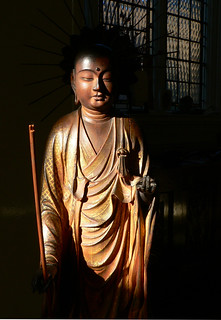Advice on starting out with Daily Life Practice
by Martin Goodson
 Sometimes people come to the Zen Centre having read or heard about the Buddha’s teachings, and understanding that these teachings are to be put into practice. The question, however, is how is that done in the Zen tradition? So this is a brief outline of basic Buddhist practice in daily life, in order to get the student started.
Sometimes people come to the Zen Centre having read or heard about the Buddha’s teachings, and understanding that these teachings are to be put into practice. The question, however, is how is that done in the Zen tradition? So this is a brief outline of basic Buddhist practice in daily life, in order to get the student started.
Students are expected to be versed in the core Buddhist Teachings such as the Four Noble Truths, the Three Signs of Being, the Skandas and Dhatus, and the Twelve-Linked Chain of Dependent Origination. In addition, they will need to acquire and read two books: “The Zen Way” and “Gentling the Bull”.
To begin, students must start with the Daily Life Practice which is the beginning, middle and end of the training. Although it sounds easy, only a fully-fledged Buddha can carry it out perfectly 24 hours a day! Quite simply, it is to give me wholeheartedly into what, at this moment, is being done. When I give myself into an activity, the feeling of ‘me doing’ disappears and an open awareness arises. This happens quite naturally when I am doing something I really enjoy – a hobby for example. This is why I enjoy my hobbies because given into the activity, it ‘lights up’, and the awareness brings everything alive. ‘I’ believe it is the hobby that works this magic and fills me with joy, but actually it is the fact that I have given myself into it that does the trick. So why don’t we do this all the time? Well, ‘I’ get in the way, with my judgements that this is interesting and that is boring. By doing this, I will not give myself into those things that ‘I’ judge as boring, and, lo and behold, they feel boring!
So, the first thing is to cultivate the habit of giving myself into all activities as wholeheartedly as possible, and, whenever awareness arises that I have ‘gone off’ into daydreams and thoughts, to bring myself back with a jerk into the activity again. To help us with this we bring the body into the action; you will find it easier to use physical work as a gateway into this giving of myself – try it out and see what happens! The books mentioned above give more details on this practice.
It is particularly useful to adopt a timetable in order to become aware of those moments during the day when something inside, one of my judgements, comes up and says ‘No!’ Once at home in the body we become aware of just how much of life we refuse in this way, and get used to containing those reactions and saying ‘Yes!’ to life instead. This is the practice of working with the Three Fires. In Zen, an analogy is used of a Bull gradually being gentled. This gentling process is a life-long one. However, in the process, we become acquainted with that Bull and realise that in fact, it is our own heart, filled with energy and possessing wisdom I could not imagine. What is more, we discover that, unbeknown to me, I had been searching for this heart all along. It was there all the time, only ‘I’ did not or could not realise it.
Please experiment with this practice of giving yourself wholeheartedly, as much as possible and as often as possible. The Buddha said that we should test his teachings as a goldsmith tests gold, ‘by rubbing and burning’.
Happy experimenting!
